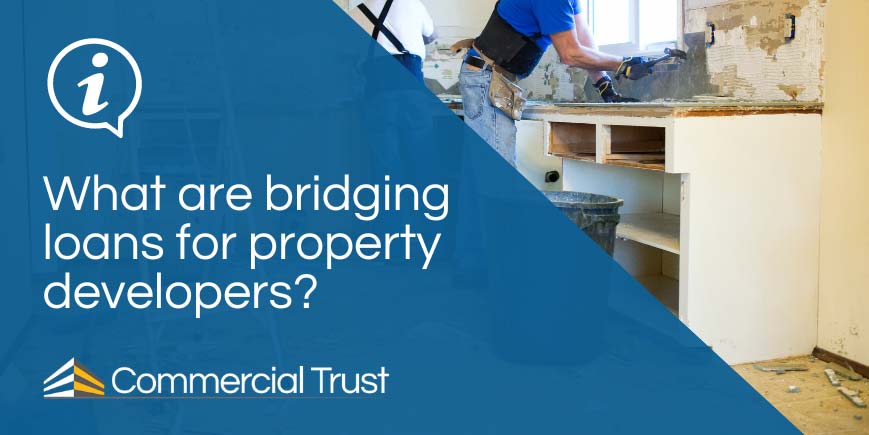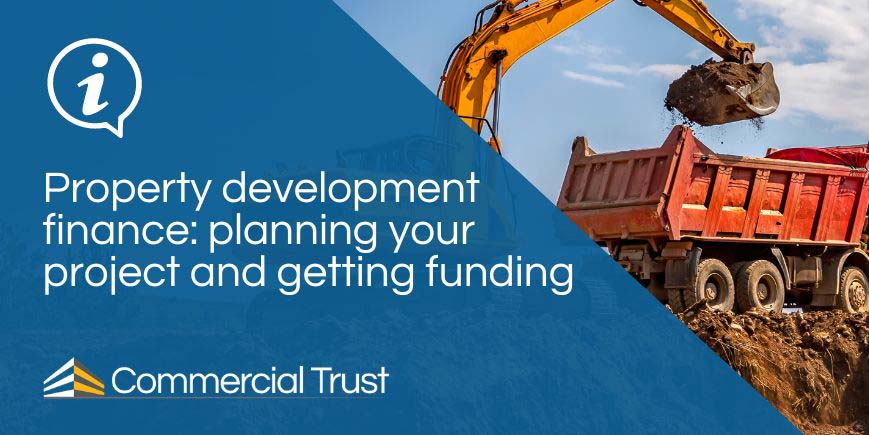This information should not be interpreted as financial, tax or legal advice. Mortgage and loan rates are subject to change.

Categories: guides | development finance guides
Developing commercial property for resale or investment is expensive. If you don’t have the money to cover the full cost yourself, or your financial strategy means you would rather borrow and invest only a proportion of your own money, you will need commercial property development finance.
Development finance provides a loan that releases lump sums of cash at appropriate points, so that you can use it to purchase land, pay builders, and cover other costs as the project progresses. As each key stage in the project is completed, more money for the next step is made available.
In this guide to development financing, we’ll answer all of the following questions and more:
When should you use it?
Commercial property development finance can be used for a variety of ground-up commercial projects, or in some instances large scale renovations, including:
Developing to sell
When you’re working on a new project, commercial development finance can help you to cover the initial and ongoing costs. It can provide the financing you need to purchase the initial plot of land, after which you can take additional portions to cover the building work.
The lender will consider the end value of the property when processing your application. Lenders typically inspect the site prior to each stage of development to ensure that everything is going as planned, before releasing the next tranche of funds. The borrower is usually charged for these visits.
At the end of the project, the property is sold to pay back the loan and with a view to making a profit.
Developing to invest
The process of securing commercial development finance, when you intend to keep the property(ies), is the same as developing to sell. The only difference is that you will repay the loan with a commercial mortgage (or semi-commercial mortgage if the property also has residential elements).
There are a couple of options available to you when you refinance.
Let’s assume that the property you have built is worth considerably more than your costs to date on the project (given that will be the intention). You could simply use that higher value to benefit your borrowing power on the mortgage.
Alternatively, you could release some of the increase in value as cash, and use the remainder for your long term borrowing.
Building your business
You can also build a commercial property to house your own business. In such cases, the lender will assess the case based on the expected value of the premises at the end of the build, as if it were to be sold on the open market.
The commercial development finance lender will want to see you have long-term finance lined up – e.g. the commercial mortgage that you will use to pay off the development finance. The commercial mortgage lender will look at the performance of your business, to see if the payments are likely to be affordable.
A large renovation project
If extensive renovation is required and you don’t have the funds to get over the line, commercial property development finance can step in.
Why should you use it?
As long as you have a predefined strategy for repaying the loan (known as an “exit strategy”), commercial development finance is an appropriate funding solution for a ground-up build of a business premises.
If you do not have the cash to fund the project yourself in full, it is the next most obvious option.
You can typically borrow for between 12 – 36 months, which you can arrange based on the volume of work that needs doing and the time it will take to complete.
How does commercial development finance work?
The best way to show you how development finance works is to look at an example.
Let’s suppose that you have your eye on a plot of land. You’ve done your sums, assessed your capital, and know that there’s money to be made.
The land costs £200,000. On top of this, you anticipate building costs of £800,000. You have £400,000 to put down as a deposit.
If your lender agrees to give you 60% of the cost of the land and 60% of the build costs:
- Total cost = £1 Million
- Land cost = £200,000
- Build costs = £800,000
- Total development finance (from the lender) = £600,000
- Land finance = £120,000
- Build finance = £480,000
- Developer deposit required = £400,000
- Land costs = £80,000
- Build costs = £320,000
You get the initial land cost to cover the purchase of the land. After that, the build costs are released in stages, typically on a monthly basis.
Once the loan period ends, you repay it in full, along with the interest that has accumulated every month as per the advertised rate.
The differences vs a commercial mortgage
Commercial mortgages and commercial development finance are used for very different purposes.
Commercial mortgages are used to purchase existing buildings—they have been built, plumbed, fitted, and are ready to trade from. Commercial development finance, on the other hand, is used to fund ground-up builds.
Commercial mortgage borrowing can be taken over many years; development finance is typically repaid between 12 and a maximum of 36 months.
The differences vs a bridging loan
A bridging loan is suitable for funding renovations, not ground-up builds. Lenders will typically offer different sorts of products based on the amount of renovation work required.
Light refurbishment bridging loans are suited to projects where the renovations are relatively minimal, e.g. refitting a kitchen and bathroom and redecoration work.
Heavy refurbishment bridging loans are for larger scale works that may require planning permission, e.g. mezzanine floors, moving walls, extensions, adding a new storey to a building.
However, bridging loans are not suitable to fund building a property from scratch.
The costs you can expect
There are three main figures associated with development finance loans:
- The amount you borrow.
- The amount you repay (interest).
- The fees (administration fees from the lender, legal costs, planning costs etc).
Borrowing amount
Development loans vary in scope, but they usually begin at around £200,000 and scale up to millions of pounds. The exact limits will depend on the lender, but your project is just as important.
If you’re buying land and building property, the lender will calculate the Gross Development Value (GDV) or anticipated worth, and then provide a maximum figure based on their Loan to Value (LTV) limits.
See the calculation mentioned previously for an example.
Typical interest rates
Interest payments are calculated monthly and vary greatly based on the lender, borrower, and project.
With development finance you only have the option to pay on an interest-only basis. This means you are paying interest on the borrowing, as opposed to any of the capital lump sum you have borrowed, which is paid off at the end of the term.
These interest only payments are typically set up as follows:
The first sum of money released to you from the lender, of the total you will borrow, will already have had the interest chargeable taken off it.
So, say the total borrowing was £300,000 but the first payment to you, to buy the land was £95,000 and the interest was £5,000, your first “gross” payment (the cash lump sum and the interest) would be £100,000, but the actual money you would receive would be £95,000 as the interest of £5,000 had been deducted.
This is described as the interest having been ‘retained’.
Then let’s assume you received the remaining £200,000 in two further payments of £100,000 each. These subsequent payments, or “drawdowns” will not have the interest chargeable deducted from them when you receive the money as was the case with the first payment. This is known as “rolled up” interest.
Instead, the interest will be calculated monthly, and added to the loan monthly until you pay off the loan (either by selling the property or keeping the property to use or rent out, for which you might use a commercial mortgage).
Fees
There are a few fees to consider when taking out a development loan:
- Product fee: This is charged by the lender and is usually 1-2% of the loan amount.
- Valuation fee: A chartered surveyor is instructed by the lender but paid for by you to establish the gross development value (GDV) of the project.
- Exit fee: This is charged by the lender. It is paid when you pay back your borrowing. It varies from between 1 and 2% of the loan. It is not charged by all lenders.
- Other fees: You may also need to pay for project managers, surveyors, solicitors, and other professionals.
- Broker fee: a broker can provide an invaluable service in helping you find a suitable lender.
Commercial development finance eligibility
A lender will consider the following three key considerations (in order of importance) before giving you a commercial development loan:
- Your experience: The lender will consider your previous experience and determine whether or not you have the right credentials.
- Your exit strategy: You must prove to the lender that you can repay the loan when the time comes.
- Your credit rating: Although it’s not a deal-breaker, it helps to have good credit.
In addition to this, they will review the following when assessing the application and terms of the deal:
The finance period
Most commercial development loans run for between 12 months – 36 months. Your schedule of works will influence whether the lender will agree to the term you are asking for. If it is accurate, the lender is likely to approve this aspect of your application.
If they feel it is inaccurate they will offer terms based on a longer borrowing period. If you do then meet a shorter timeframe you can still exit the loan at this point.
The type of development
A lender will look at the type of development and schedule of works to assess the gross development value of the completed build, which will influence their decision on the amount they are prepared to lend.
The size of the loan
Your desired loan size must fall within the lender’s range.
What’s the best way to get commercial development finance?
The best way to find the right finance for you is to apply through a broker—a specialist advisor who can walk you through the process and ensure you get the best deal. Visit our development finance page to learn more, or enquire here.
FAQs
If you still have a question about commercial development finance, check out the following FAQs:
Development exit finance describes paying off development finance with another type of borrowing when you have run out of time, or money, to complete your planned work.
Yes this may be possible (depending on the amount and recency of the bad credit). But, as with other types of loans, it may restrict your choice of lenders and could mean you won’t have access to the best rates.
Planning permission will be required for a ground-up development. However, depending on the scale of the works required some developments can be completed using “Permitted Development Rights”, which means you can make certain changes to a building without needing planning permission.





